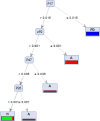Measuring Compounds in Exhaled Air to Detect Alzheimer's Disease and Parkinson's Disease
- PMID: 26168044
- PMCID: PMC4500505
- DOI: 10.1371/journal.pone.0132227
Measuring Compounds in Exhaled Air to Detect Alzheimer's Disease and Parkinson's Disease
Abstract
Background: Alzheimer's disease (AD) is diagnosed based upon medical history, neuropsychiatric examination, cerebrospinal fluid analysis, extensive laboratory analyses and cerebral imaging. Diagnosis is time consuming and labour intensive. Parkinson's disease (PD) is mainly diagnosed on clinical grounds.
Objective: The primary aim of this study was to differentiate patients suffering from AD, PD and healthy controls by investigating exhaled air with the electronic nose technique. After demonstrating a difference between the three groups the secondary aim was the identification of specific substances responsible for the difference(s) using ion mobility spectroscopy. Thirdly we analysed whether amyloid beta (Aβ) in exhaled breath was causative for the observed differences between patients suffering from AD and healthy controls.
Methods: We employed novel pulmonary diagnostic tools (electronic nose device/ion-mobility spectrometry) for the identification of patients with neurodegenerative diseases. Specifically, we analysed breath pattern differences in exhaled air of patients with AD, those with PD and healthy controls using the electronic nose device (eNose). Using ion mobility spectrometry (IMS), we identified the compounds responsible for the observed differences in breath patterns. We applied ELISA technique to measure Aβ in exhaled breath condensates.
Results: The eNose was able to differentiate between AD, PD and HC correctly. Using IMS, we identified markers that could be used to differentiate healthy controls from patients with AD and PD with an accuracy of 94%. In addition, patients suffering from PD were identified with sensitivity and specificity of 100%. Altogether, 3 AD patients out of 53 participants were misclassified. Although we found Aβ in exhaled breath condensate from both AD and healthy controls, no significant differences between groups were detected.
Conclusion: These data may open a new field in the diagnosis of neurodegenerative disease such as Alzheimer's disease and Parkinson's disease. Further research is required to evaluate the significance of these pulmonary findings with respect to the pathophysiology of neurodegenerative disorders.
Conflict of interest statement
Figures


Similar articles
-
Detection of Alzheimer's and Parkinson's disease from exhaled breath using nanomaterial-based sensors.Nanomedicine (Lond). 2013 Jan;8(1):43-56. doi: 10.2217/nnm.12.105. Epub 2012 Oct 15. Nanomedicine (Lond). 2013. PMID: 23067372
-
Oligomeric α-synuclein and β-amyloid variants as potential biomarkers for Parkinson's and Alzheimer's diseases.Eur J Neurosci. 2016 Jan;43(1):3-16. doi: 10.1111/ejn.13056. Epub 2015 Oct 15. Eur J Neurosci. 2016. PMID: 26332448 Free PMC article.
-
Using cerebrospinal fluid marker profiles in clinical diagnosis of dementia with Lewy bodies, Parkinson's disease, and Alzheimer's disease.J Alzheimers Dis. 2014;38(1):63-73. doi: 10.3233/JAD-130995. J Alzheimers Dis. 2014. PMID: 23948928
-
Simultaneous analysis of cerebrospinal fluid biomarkers using microsphere-based xMAP multiplex technology for early detection of Alzheimer's disease.Methods. 2012 Apr;56(4):484-93. doi: 10.1016/j.ymeth.2012.03.023. Epub 2012 Apr 6. Methods. 2012. PMID: 22503777 Review.
-
Recommendations to standardize preanalytical confounding factors in Alzheimer's and Parkinson's disease cerebrospinal fluid biomarkers: an update.Biomark Med. 2012 Aug;6(4):419-30. doi: 10.2217/bmm.12.46. Biomark Med. 2012. PMID: 22917144 Review.
Cited by
-
Fecal Volatile Organic Compounds and Microbiota Associated with the Progression of Cognitive Impairment in Alzheimer's Disease.Int J Mol Sci. 2022 Dec 31;24(1):707. doi: 10.3390/ijms24010707. Int J Mol Sci. 2022. PMID: 36614151 Free PMC article.
-
Volatile Phases Derived from Serum, DC, or MLC Culture Supernatants to Deduce a VOC-Based Diagnostic Profiling Strategy for Leukemic Diseases.Biomolecules. 2023 Jun 14;13(6):989. doi: 10.3390/biom13060989. Biomolecules. 2023. PMID: 37371569 Free PMC article.
-
Detection of Volatile Organic Compounds as an emerging strategy for Parkinson's disease diagnosis and monitoring.NPJ Parkinsons Dis. 2025 Jun 12;11(1):161. doi: 10.1038/s41531-025-00993-2. NPJ Parkinsons Dis. 2025. PMID: 40506424 Free PMC article.
-
A fast and non-invasive artificial intelligence olfactory-like system that aids diagnosis of Parkinson's disease.Eur J Neurol. 2024 Mar;31(3):e16167. doi: 10.1111/ene.16167. Epub 2023 Nov 27. Eur J Neurol. 2024. PMID: 38009830 Free PMC article.
-
Electronic Nose: Recent Developments in Gas Sensing and Molecular Mechanisms of Graphene Detection and Other Materials.Materials (Basel). 2019 Dec 22;13(1):80. doi: 10.3390/ma13010080. Materials (Basel). 2019. PMID: 31877901 Free PMC article. Review.
References
-
- Cummings JL. Alzheimer's disease. N Engl J Med. 2004;351(1):56–67. . - PubMed
-
- McKhann GM, Knopman DS, Chertkow H, Hyman BT, Jack CR Jr., Kawas CH, et al. The diagnosis of dementia due to Alzheimer's disease: recommendations from the National Institute on Aging-Alzheimer's Association workgroups on diagnostic guidelines for Alzheimer's disease. Alzheimers Dement. 2011;7(3):263–9. 10.1016/j.jalz.2011.03.005 - DOI - PMC - PubMed
Publication types
MeSH terms
Substances
LinkOut - more resources
Full Text Sources
Other Literature Sources
Medical

